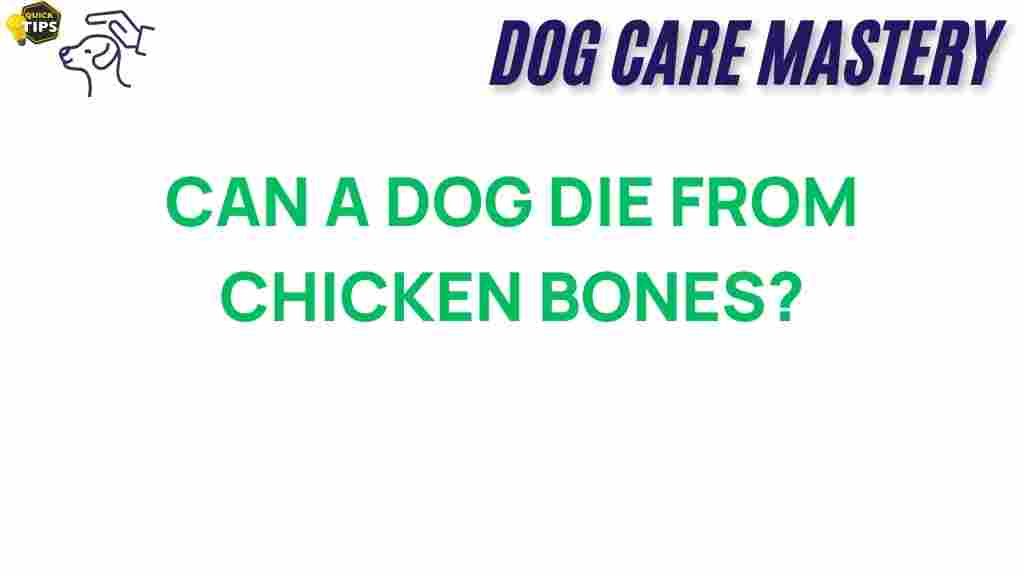Understanding Dog Safety: The Hidden Dangers of Chicken Bones
When it comes to our furry friends, dog safety is a top priority for every pet owner. We often share our meals with our pets, sometimes without considering the potential hazards involved. One such common food item that raises concerns is chicken bones. While it might seem harmless to toss your dog a leftover chicken bone, the reality is quite the opposite. In this article, we will explore whether a dog can die from chicken bones, the hidden dangers associated with them, and how to ensure the safety of your beloved pet.
The Risks of Feeding Chicken Bones to Dogs
Before diving into the specific dangers, it’s essential to understand what makes chicken bones particularly hazardous for dogs. Unlike larger bones, chicken bones are small and can splinter easily, which poses a severe risk to your dog’s health.
- Splintering: When a dog chews on a chicken bone, it can break into sharp pieces. These splinters can cause serious internal injuries.
- Obstruction: A larger piece of bone can get lodged in a dog’s throat or digestive tract, leading to choking or blockage.
- Perforation: Sharp bone fragments can puncture the stomach or intestines, resulting in life-threatening situations.
- Dental Damage: Chewing on hard bones can also lead to broken teeth, which can be painful and require veterinary care.
Signs That Your Dog May Have Ingested Chicken Bones
It’s crucial to monitor your dog for any signs of distress after they’ve eaten chicken bones. Here are some symptoms to watch for:
- Vomiting or gagging
- Abdominal swelling or pain
- Blood in stool or vomit
- Difficulty breathing or swallowing
- Lethargy or lack of appetite
If you notice any of these symptoms, it’s vital to contact your veterinarian immediately. Early intervention can be critical in addressing any complications related to bone ingestion.
What to Do If Your Dog Eats Chicken Bones
If your dog accidentally consumes chicken bones, here’s a step-by-step process to follow:
- Stay Calm: Your dog may sense your anxiety, which can lead to them becoming more stressed.
- Assess the Situation: Determine how many bones your dog may have eaten and whether they have shown any immediate symptoms.
- Monitor Your Dog: Keep a close eye on your dog for the next few hours for any signs of distress.
- Contact Your Veterinarian: If you notice any concerning symptoms or if your dog has consumed a significant amount of bones, call your vet for advice.
- Follow Your Vet’s Instructions: Your veterinarian may suggest bringing your dog in for an examination or monitoring them closely at home.
Preventing Chicken Bone Incidents
To ensure your dog’s safety, prevention is always better than cure. Here are some tips to keep your dog safe from chicken bones:
- Educate Family Members: Make sure everyone in your household understands the risks of feeding chicken bones to dogs.
- Secure Food Waste: Keep trash bins sealed and inaccessible to your pets to prevent them from scavenging for bones.
- Provide Safe Chew Alternatives: Offer your dog safe chew toys or bones specifically designed for dogs instead of chicken bones.
- Cook Without Bones: When preparing meals, consider using boneless chicken options or properly disposing of bones before allowing your dog near the table.
What to Do If Your Dog Shows Symptoms
If your dog is showing signs of distress after consuming chicken bones, here are some troubleshooting tips:
- Do Not Induce Vomiting: Unless advised by your veterinarian, do not attempt to make your dog vomit, as it can cause further complications.
- Keep Your Dog Calm: Create a calm environment to help reduce stress; this includes avoiding any physical activity that could aggravate the situation.
- Gather Information: Take note of when your dog ate the bones and what symptoms they are experiencing to provide your vet with accurate information.
- Prepare for a Vet Visit: If necessary, be ready to take your dog to the vet for an examination. They may need X-rays or other diagnostic tests.
Alternatives to Chicken Bones
While chicken bones pose significant risks, many safe alternatives can satisfy your dog’s chewing needs. Consider the following options:
- Raw Bones: Some raw bones, such as beef or lamb bones, can be safer as they are less likely to splinter. Always supervise your dog while they chew.
- Commercial Chews: Look for dog chews made from natural ingredients that are specifically designed to be safe for canine consumption.
- Vegetable Chews: Certain vegetables like carrots can be good alternatives that provide nutritional benefits and satisfy your dog’s urge to chew.
Conclusion
In conclusion, dog safety is paramount, and understanding the hidden dangers of chicken bones is essential for every pet owner. The risks associated with chicken bones—such as splintering, obstruction, and perforation—can lead to severe health issues, potentially even death. By being vigilant and proactive, you can prevent such incidents and ensure the well-being of your furry friend.
Always educate yourself and others about the risks of feeding inappropriate foods to dogs, and provide safe alternatives that promote good health. Remember, your dog’s safety is in your hands, and every measure you take counts toward a long, healthy life for your beloved pet.
For more information on dog safety, you can check out this comprehensive guide. If you’re looking for alternatives to chicken bones, visit this resource for safe dog treats and chews.
This article is in the category Safety and created by dogcaremastery Team
